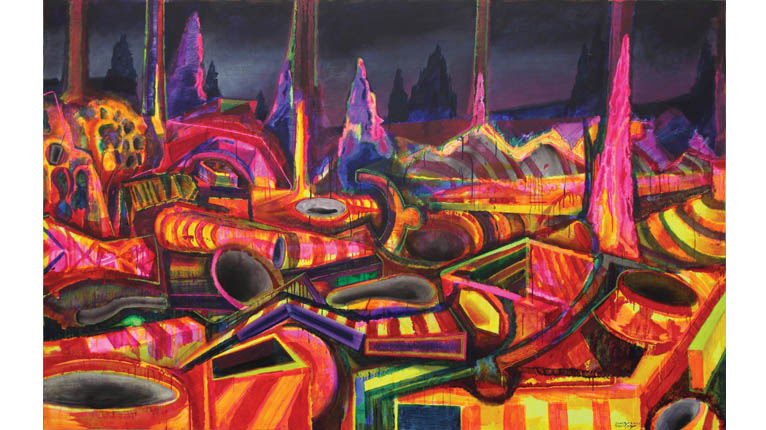HUANG YUXING
| July 27, 2012 | Post In LEAP 15

Over the past several years, Huang Yuxing’s works have undergone continuous, linear change, both in terms of their composition and their themes. Beginning with his “Keyhole” series, Huang left audiences with an impression that was often somber, through works marked by emotional doubt and private inquiry. Then, with the unfolding of key personal and global events, his works saw a change, most obviously evidenced by the influx of large swaths of color, all but entirely drowning out the sharp, peering eye of “Keyhole.” Intricately formed structures had been exchanged for cold, austere lines. Bit by bit, the focal point of Huang’s work began to expand outward, from a narrative born of intense interest in the enclosed spaces of the private and hidden to a collective dialogue taking place in open air. In terms of theme, he has also gradually swept all traces of explicit reference in favor of the innominate realm lurking beneath.
The works in this exhibition were all painted in 2012. Some of the features latent in Huang Yuxing’s works last year have become clear themes in this year’s works. Though the title of each piece— Trap, Colosseum, Podium, Club of Law Enforcers— evokes a sort of static framing of events, Huang takes simple geometric forms and weaves them together to render complex and vibrant spatial fields. He alternates between acrylic and oil, producing a consistency suspended between thick and thin, leaving conspicuous brush strokes in his wake. Graphic images are richly saturated with color, and each pigment jumps out of the canvas. Fluorescent notes and a gradient rainbow of blue call to each other in a grand sounding of light and depth: a contrast that endows pure image with heavy, complicated significance. Here, Huang reveals a pronounced desire to impress upon his audience the weight of expression itself; color is the main focus of these works, and color, on its own, begins to convey the artist’s very moods and intentions.
From here, Huang Yuxing’s creations may be considered “expressionist.” Huang has said that he takes inspiration from Marlene Dumas, and this is a series that undoubtedly responds to her influence. But in contrast to other moments from his past, Huang is fascinated by the tension produced by colors. As brilliant patches of color are smeared over a canvas, the reality that a work originally intended to portray is subject to real, material changes at the hands of simple shapes and warm hues. The picture plane becomes surreal, and in the process, the connotation of the work itself undergoes change. There is no way to point to any one reality; abstract suspicion hangs like a cloud over the worlds hidden within his paintings. But at the same time, the physical forms of these worlds are not entirely illegible, allowing for an accentuation of contrast between possible realities. By surging outward from the canvas and altering his technique, Huang Yuxing allows rigid, direct associations to thaw out, dissipating slowly as a new value, shrouded in ambiguity, emerges.
Huang Yuxing’s first solo exhibition at Beijing Commune is a kind of declaration, marking a transition from the private and concrete to the shared and abstract. It is Huang’s attempt to realize his own personal breakthrough, manifested in brushstrokes more notable than ever before for their sense of individuality. With this attempt, Huang has carved out a new space for the growth and evolution of his work. However, the richness of his creations also lies precisely in their movement forward, in the transit between the so-called private and public, the figurative and abstract: they are all born of relation. Audiences will not be clear as to whether the lonely scene they perceive truly exists on the canvas, or within life itself— or if, as before, it is part of a far away dream, belonging to the secret world of the artist. Liu Xi (Translated by Katy Pinke)


